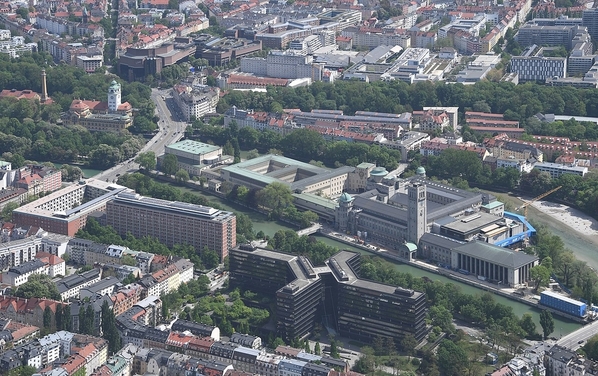It's not hard to find engineering-and-technology oriented museums in Germany, as I discovered on my visit last summer, but the largest, and with the most inclusive name, is based in Munich, with the simple name Deutsches Museum, or The German Museum.
The main museum is a huge building, first opened in 1925 and repeatedly extended and rebuilt, on its own island in the Isar River, adjacent to the city center. That's it above, with its slim tower.
When I say it's based in Munich, that's because it's recently spawned a number of branches, each with its own focus. It has a transport museum, the Verkehrszentrum, on the other side of town. Its aviation branch is 18km away at what was one of Germany's first military airbases. In Bonn, it focuses on German research and technology after 1945, and its latest, in Nuremberg, focuses on future technology.
Despite that scattering of tasks, there's plenty, perhaps even too much, to see in one go at the main museum. The tugboat, named for a former president of Germany, seems as if it's waiting for the right time and place to be an exhibit; for now, it's just parked in a courtyard.
We started by watching parts of a talk on DNA research given in an open amphitheater, with exhibit panels from a climate change presentation tucked away behind the screen.
From there we moved on to an extensive exhibit on robotics, which not only showed off some gee-whiz capabilities, but discussed issues that arise, including the 'uncanny valley' conundrum: The more human a robot appears, the more familiar it seems, but if it gets too human-like, it becomes eerie and disturbing to many.
The two robots below illustrate that issue: the robot deliverer is obviously a robot, but the teacher/secretary/receptionist/whatever could raise the discomfort level for some.
Past the robots, we encountered a small exhibit about the history of railroads (the main exhibits being at the Verkehrszentrum) and a section of operating model trains, used to make the point that using models is an important way of planning and preparing for actual construction or development.
From there, the world of heavy industry, big machines and the principles behind them, and how different versions based on the same principles are used in different applications.
Past the turbines and engines, there's an aircraft exhibit, even though the main aviation exhibit is elsewhere. It shows mostly fairly recent planes, including cabin and cockpit mockups of several recent airliners. And one not-so-recent...
There was a log going on in the children's activity area, but since we had no children on hand, we could only glance in.
Civil engineering exhibits included this very realistic-looking mine tunnel, which actually only extended about eight feet before 'disappearing' into the photograph at the end. After that, the world of bridges.
The bridge section is one of the largest, with models and working displays of far too many bridges and types to include here, from ancient to modern.
A model hydro-electric dam
And on into space, where there are exhibits from a number of countries, and an emphasis on how countries have cooperated in space programs.
Nearby, some older planes, including a Junkers JU-52, the Iron Annie of German and European aviation, civil and military, for many years. The Museum's example was actually built in France after World War II in a factory that had been taken over by Germany during the war.
We passed through a section with science education models, including a rather alarming 1950s chemistry set with radioactive samples and a box which may, or may not, contain Schrodinger's Cat.
Our last exhibits of the day were in an entirely different vein; I don't often think of music in terms of technology, other than today's electronically-generated or enhanced music, but the Deutsches Museum's large display of early keyboard instruments reveals the changes and developments that brought us to today's instruments.
Quite a bit different from the keyboards, both synthesizer and computer, that accompany today's composers and artists.



Comments (0)